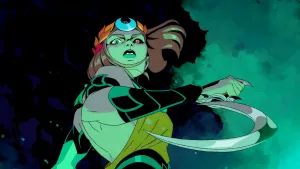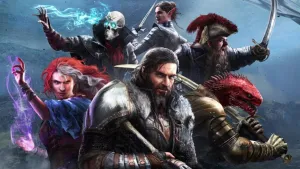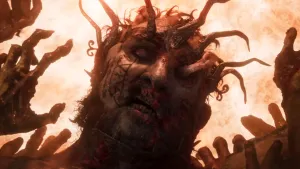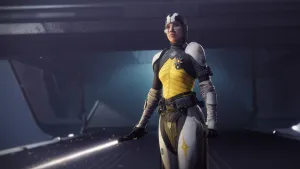Sterner Stuff: The History Of The Transformers
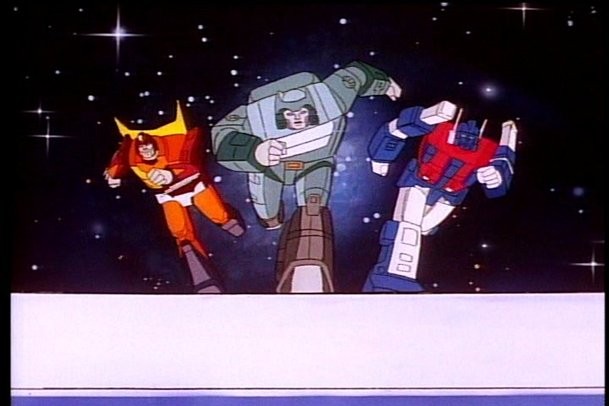
As of 2009, The Transformers are 25 years old -- older if you look to their Japanese roots. In this span of time, the series of toys has invaded every medium imaginable and developed a rabid fan following with size and lasting power that all but the most popular franchises would blush at. But one area they've yet to conquer is the world of video games.
High Moon Studios’ Matt Tieger, game director for Transformers: War for Cybertron, has pitched the upcoming title as "the game I've been waiting 25 years to play," a sentiment he hopes will be echoed by many long-time franchise followers who have yet to receive a satisfying virtual incarnation of the robots in disguise. Just what is it that Transformers fans are looking for in a game that they would wait this long for it? I decided to take a look back at the long history of the Transformers across various forms of entertainment to figure it out and to see just how much can happen in 25 years.
If you want to read about a specific form of Transformers, you can skip ahead. The article covers the various mediums in the following order: Cartoons and Movies on page 2, Toys on page 3, Comics on page 4, and Games on page 5.
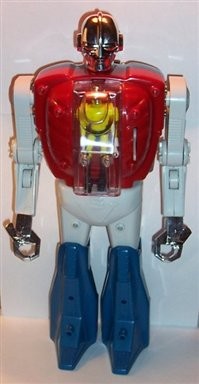
The Origins
Despite becoming a sensation among American children of the '80s, the Transformers craze actually began in Japan with a toy company named Takara. In 1974, Takara launched a line of toys in Japan called Microman, a series of small but impressively detailed action figures that included robots and vehicles with interchangeable parts (such as Robotman, pictured to the left). A spin-off toy line named Diaclone was launched in 1980 and introduced vehicles that transform.
The Microman toys first made their way to the U.S. in 1976 under the name Micronauts, but as the Mega Corporation neared bankruptcy, the Micronauts toy line was cancelled in 1980. A few years later in 1984, Hasbro was wise enough to buy up rights for the Diaclone and Microman toy lines, which they rebranded as Transformers, focusing on the concept of big, detailed robots that could transform into cars, jets, and more.
Hasbro's smart ideas didn't stop there. The company also decided to introduce the toys to the public with a cartoon series simply titled The Transformers. This is where many kids got their first taste of Transformers.
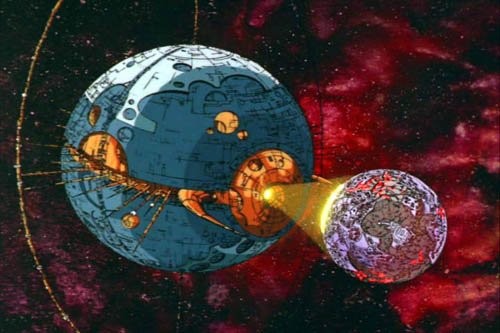
The Cartoons and Movies
The original Transformers animated series launched alongside the toy line in 1984, introducing eager viewers everywhere to the epic conflict between the Autobots (led by the heroic Optimus Prime) and the Decepticons (headed by the manipulative Megatron). The storyline was simple but intriguing: The two warring factions of robots leave their homeworld of Cybertron in search of Energon, a major source of power for the robots. After a fight and a dramatic crash landing, both factions are out of commission for millions of years before waking up on Earth in the year 1984.
Most episodes of the cartoon consisted of Megatron coming up with a plot to destroy the Autobots, gain more Energon, take over the Earth, or all three -- followed by the Autobots slowly unraveling and thwarting his plan. New characters were introduced constantly, but a handful of fan favorites often took center stage, including Starscream, Soundwave, Bumblebee, and Jazz. This simple formula made for some great action and plenty of transforming every week.
By 1986, after two seasons of the cartoon, the show had grown popular enough that it earned its very own feature-length animated movie. Skipping ahead in the series’ timeline to the year 2005, Transformers: The Movie upped the ante, forcing the Autobots and Decepticons to unite against the powerful planet-sized Unicron (pictured above and voiced by Orson Welles in his final film performance ever). The movie featured introductions for numerous new characters as well as the dramatic deaths of several classic Autobots and Decepticons, which lent the story some weight and gave Hasbro the opportunity to phase out some lesser-selling toys in favor of new models. One of the casualties of the movie was even Optimus Prime himself, though he ended up returning by the end of the cartoon's third season.
The original cartoon ended with the fourth season in 1987. At the end of the series, the Autobots finally won "for good," taking back Cybertron and restoring it to peace, though the Decepticons remained lurking in the background, sure to strike again. While this completed what's commonly referred to as "Generation 1" in America, the G1 storyline continued in Japan, where three more 30 to 40-episode series were created: Transformers: The Headmasters, Transformers: Super-God Masterforce, and Transformers: Victory.
After a five-year break, Transformers returned to the world of cartoons in 1993 with Transformers: Generation 2. Despite a new toy line to draw on, this series was mostly repeats of the original animated series with some flashy computer-generated transitions thrown in.
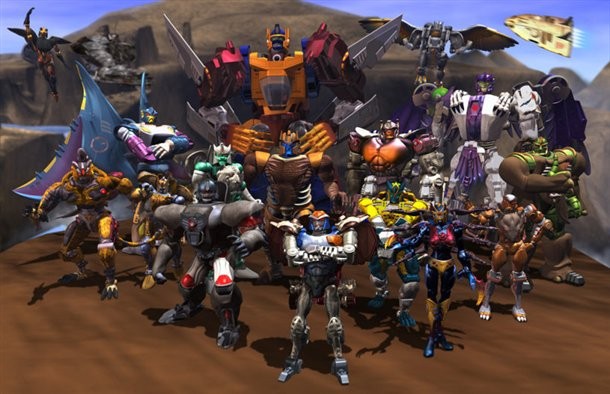
In 1996, Transformers fans finally got the new content they'd been craving in the form of Beast Wars. This series mixed things up with two new-yet-familiar factions, the Maximals and the Predacons, Transformers that morphed into animal forms rather than vehicles. These new bodies helped them through the show’s lush, computer-generated jungle environments. Through three seasons of tightly-plotted episodes, Beast Wars eventually revealed that the Maximals and Predacons had traveled back in time and were fighting on prehistoric Earth. Funny how that's always the crash-landing spot for Transformers.
As with the original Transformers animated series, two Japan-only series were spun off from Beast Wars: Beast Wars II and Beast Wars Neo. These series switched back to hand-drawn animation and featured a new futuristic Earth setting for the fights between the Maximals and Predacons.
In 1999, America received Beast Machines: Transformers, a two-season continuation of Beast Wars. This series documented the continuing fight against Megatron on Cybertron, but it also bothered many long-time fans by introducing the concept of organic life to the Transformers and their homeworld. Interestingly, Beast Machines ended with the near-simultaneous death of both sides’ leaders, Optimus Primal and Megatron, hitting home the message of balance that it had focused on.
In 2000 and 2001, Hasbro did the first in a series of continuity reboots for the Transformers franchise. The Japanese animated series Transformers: Car Robots was brought over to the U.S. under the name Transformers: Robots in Disguise. This very anime-influenced show found the Autobots fighting the Predacons this time, with the Decepticons as a separate third faction introduced later in the series. The series also introduced Omega Prima, a powerful robot created from combining Optimus Prime and his brother, Ultra Magnus.
However, many fans view Robots in Disguise as a placeholder that was simply meant to fill time until the beginning of an epic three-series run. This new "Unicron Trilogy" began in 2002 with Transformers: Armada and continued with Transformers: Energon and Transformers: Cybertron. Once again rebooting the Transformers lore, Armada saw the Autobots and Decepticons fighting for control over a brand new group of characters, the Mini-Cons. This smaller form of robot links up to the regular-sized Transformers to increase their power.
The later series, Energon and Cybertron, experimented with a more polished computer -generated art style than Beast Wars. The Decepticons and Autobots briefly became allies, and both Megatron and Unicron were defeated, resurrected, and defeated again. The Cybertron series stood out from the rest, as it was launched in Japan as another reboot but was shoehorned into the Armada continuity in America. It focused more heavily on the galactic elements of the Transformers, with the Autobots visiting different planets and meeting unique characters and factions in each episode.
In 2007, the Transformers brand was revitalized in the mainstream with its first-ever live-action movie, a summer blockbuster directed by Michael Bay and starring Shia LaBeouf and Megan Fox. In this latest reimagining, the Transformer homeworld of Cybertron had been destroyed altogether by Megatron, who was seeking an ancient artifact called the All Spark. The concept of the All Spark had been previously introduced during the Beast Machines series, but it's much more fleshed out in the film as a cube that can heal or create new Transformers.
Cartoon nostalgia paid off; the live-action film was a big enough hit that a sequel was green-lit and rushed into production immediately. Two years later, in the summer of 2009, Transformers: Revenge of the Fallen opened in theaters, quickly earning a flood of critical disdain matched only by its extremely strong box office performance. In fact, Transformers: Revenge of the Fallen currently holds the record for third largest opening day box office for a movie ever (behind The Dark Knight and New Moon).
The plot of the film explores the Fallen, an ancient evil Transformer only briefly introduced previously in the Transformers comics. In the film, Megatron kills Optimus Prime and then frees the Fallen from captivity, after which the Fallen becomes the true leader of the Decepticons. By the end of the film, Optimus is revived and the Fallen is destroyed, though Megatron survives and retreats. The live-action film series will continue; Paramount has already announced a third Transformers movie currently scheduled for the summer of 2011.
Along with the first live-action film, Hasbro also launched a new cartoon series, Transformers Animated. Yet another reboot, Animated had a much more kid-friendly, cartoony vibe than any of the previous series, including a very colorful aesthetic. Plot-wise, it borrowed elements from the original series and the new live-action film while blending in its own eccentricities. The Autobots end up stranded on Earth again, but this time they're headquartered in Detroit of all places and fight human super-villains in addition to the Decepticons. They also befriend a human child like in the original animated series – this time a young girl named Sari – but she discovers that she's actually a robot in the end of the second season.
Transformers Animated ended its run in 2009 with its third season. Judging b y the length of this history of cartoons, though, Hasbro will almost certainly have another new show out before too long. Let's just hope it's not another reboot.
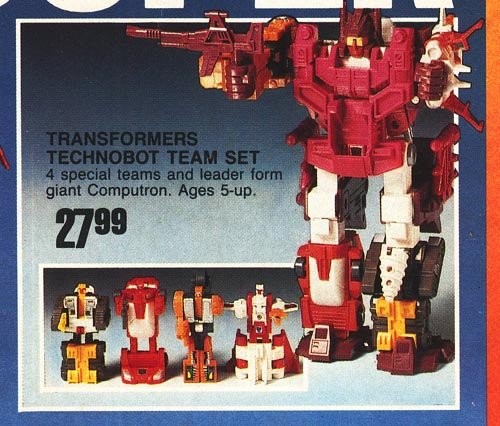
The Toys
I focused on the cartoons first because that's where most kids first met the Transformers, but that whole legacy was started and solidified based on a long-running and continuing series of strong toy releases.
As I mentioned already, the original line of Generation 1 Transformers toys were based on two Japanese toy lines that Hasbro bought the rights to. However, Hasbro's Western rebranding in 1984 proved popular enough that in 1985 Takara began remarketing the Japanese lines as Transformers as well. The original set of Hasbro toys includes 21 figures, but as the cartoon took off and new robots were introduced, this number quickly expanded.
Popular newcomers to the original line included the Dinobots, which transformed into dinosaurs instead of vehicles, and the Constructicons, the first in a long line of multiple, individually purchased toys that could combine into an even bigger robot. Other releases of interest included Fortress Maximus, a two-foot tall Transformer, and Pretenders -- Transformers that could hide themselves inside a human-looking action figure.
The first line of Transformers toys ended in 1990, after which Hasbro took a short break, relaunching with the Transformers: Generation 2 line in 1993. This line included many of the same Transformers as G1 but with tweaked color schemes. One of the biggest changes was Megatron. In his G1 form, Megatron was one of the few non-vehicle Transformers, instead changing into a handgun. With Generation 2, Hasbro changed it so he now transformed into a tank, making him seemingly much more useful in battle and also probably quelling some complaints from parents.

Unfortunately, possibly due to rehashing from G1 for both the toy line and the cartoon, the Generation 2 toys didn't take off and the line was ended in 1995. In '96, Hasbro decided to shake things up with Beast Wars, a line where every robot would transform into an animal instead of a vehicle. The risk paid off; coupled with another popular animated series, the Beast Wars line was a success.
In 1998, the Beast Wars line grew to include Transmetals, special figures with chrome metallic paint jobs. Then, in 1999 the Beast Wars line was changed to Beast Machines, although the core concept behind the toys remained essentially the same.
In 2001, Hasbro brought Takara's Car Robots line to America, renaming it (and the cartoon) Robots in Disguise. Unlike the cartoon series, fans generally loved the Robots in Disguise toy line. Optimus Prime got redesigned as a fire truck, and Megatron received a whopping six different forms: a robot, a two-headed dragon, a strange gargoyle-like creature, a jet, a race car, and a giant hand.
The 2002 Armada toy line introduced Mini-Cons, smaller robots that came in three-packs and could connect to larger Transformers to give them special features. The Armada line also included the first-ever toy release for Unicron, the powerful antagonist from Transformers: The Movie.
2002 also saw the birth of the long-running Transformers: Universe line, a continuous brand focused on re-releasing old and otherwise largely unavailable Transformers toys. At first it focused only on Generation 1 toys, but since then the Universe line has expanded to include many of the out-of-print Transformers toy lines.
In 2003, Hasbro began the Energon line, introducing a bevy of new characters, such as the Omnicon and Terrorcon factions. Many lesser-known or new robots also came packaged with Energon weapons and Energon chips that could be used by the more popular Transformers, giving fans incentive to buy them. Some Autobots also received the ability to combine into larger robots.
The Cybertron line launched in 2005 and had its own special new gimmick: Cyber Keys, which came packaged with each Transformer and unlocked special abilities when used. This line was also the first time Hasbro released a figure for Primus, the creator of the Transformers, who transforms into Cybertron itself.
In 2006, to fill space until the movie came out, Hasbro announced the Transformers: Classics line. Once again, these were re-releases of Generation 1 toys, but unlike the Universe line, they were redesigned and given a more modern look.
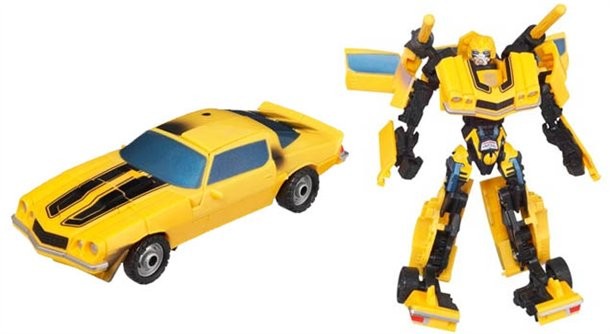
A new set of toys came out to coincide with the live-action film in 2007, but the design of these Transformers was vastly different from what fans had come to know and love. As such, reaction was very mixed. Though certain features remained from the G1 Transformers to help identify popular characters, the robots now had an alien aesthetic to their design. Fans have come to call the movie versions of the robots "Bayformers," after director Michael Bay.
Since 2007, there have been numerous new Transformers toy lines, including a run of Transformers Animated figures, a Star Wars Transformers line that featured robot versions of Luke Skywalker and Darth Vader, and a more general Crossovers brand that was kicked off with robot versions of various Marvel superheroes, such as Spider-Man and Wolverine.
Takara has also released several Japan-exclusive Transformer toy lines throughout the years. Most recently (and notably) was 2009's Transformers: Disney Label, which includes such oddities as a Mickey Mouse transformer based on Optimus Prime.
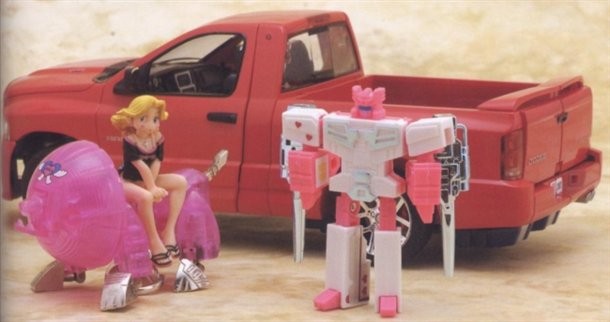
Also worth bringing up, if only for the sheer ridiculousness, is 2006's Kiss Players line. This series of toys, manga, and audio dramas (?!) was set in the Generation 1 continuity. However, it introduced the absurd concept that Transformers required little girls to kiss them (?!?!) in order to power up. I'm not kidding. Armies of girls were trained to be Kiss Players that can power up good robots to fight against evil robots. Still not kidding. Perhaps this is a taste of where Transformers lore could have gone had the franchise remained Japan-only?
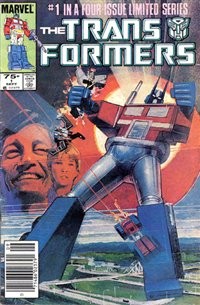
The Comics
Originally planned as a four-issue mini-series to go along with the new cartoon, Marvel began publishing The Transformers in 1984. The series ended up continuing past its fourth issue, eventually ending in 1991 with 80 issues, a number that's still as impressive by today's standards as it was then. Even more impressive was the U.K. version of The Transformers, which ran for a nigh unbelievable 332 weekly issues, most written by Simon Furman.
Though the Marvel Comic more or less stuck with the cartoon's continuity for the first two seasons of the show, it ignored the direction of the third season and continued on its own path as the cartoon reached an end. Marvel considered the book a part of the regular Marvel universe, which meant that it had occasional cameos from Marvel superheroes. They also did a crossover mini-series with G.I. Joe, another popular Hasbro toy license whose comics Marvel was publishing at the time.
In 1993, Marvel launched Transformers: Generation 2 to go along with Hasbro's new toy line and cartoon. The Generation 2 comic was an original series that did not reprint older material. Simon Furman was brought back on as a writer, and he focused on an epic, complex storyline and a dark mood that included semi-frequent character deaths. Unfortunately, Furman's plans for the Transformers were brought to an abrupt end when the series didn't perform as well as expected, causing it to be cancelled after 12 issues.
After nearly 10 years without any Transformers comics, Dreamwave Productions acquired the license in 2002. They kicked things off with a couple of mini-series that grew into an ongoing comic based around the Generation 1 continuity. However, this ongoing series only made it to issue #10 before Dreamwave stumbled into bankruptcy.
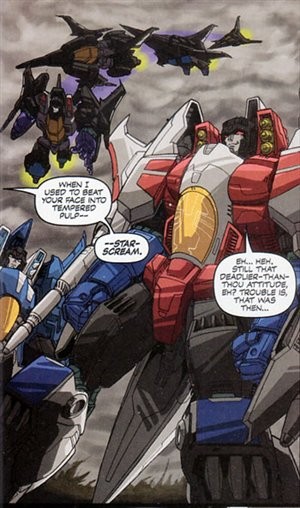 Of the numerous mini-series Dreamwave published alongside the ongoing comic, the most notable was probably The War Within (pictured to the right). Penned (once again) by Simon Furman, The War Within was a prequel to the original cartoon, focusing on Cybertron and how the war between the Autobots and Decepticons heated up. Sadly, this series was cut short as well. Originally planned as three separate six-issue miniseries, only half of the issues were published for the third volume.
Of the numerous mini-series Dreamwave published alongside the ongoing comic, the most notable was probably The War Within (pictured to the right). Penned (once again) by Simon Furman, The War Within was a prequel to the original cartoon, focusing on Cybertron and how the war between the Autobots and Decepticons heated up. Sadly, this series was cut short as well. Originally planned as three separate six-issue miniseries, only half of the issues were published for the third volume.
After Dreamwave went out of business, IDW was the next publishing house to receive the Transformers license in 2005, and they've put it to extremely good use. IDW brought Simon Furman in from the start and tasked him with creating mini-series taking place in both the Generation 1 and Beast Wars continuities. These new comics proved successful and led to a continuous stream of new mini-series and some notable crossovers, including several Transformers/G.I. Joe crossovers with Devil’s Due Publishing and a Transformers/New Avengers crossover with Marvel.
The numerous stories Furman and other IDW writers have crafted are intricately connected and have been largely collected in trade paperback form, making for easy catching up. Most recently, IDW has started a new Transformers ongoing series. Here's to hoping that this one makes it past 12 issues!
The Games
And here we are: video games. It's the reason we're all here and the one area where Transformers has consistently had trouble succeeding. And they've been trying for quite a long time.
The first Transformers game, titled The Transformers, was released for the Commodore 64 in 1986. In this limited title (see it for yourself in the video above), players chose from a variety of Autobots that could respond to Decepticon attacks at several different locations on a world map. When they arrived at the scenes, the game switched to a first-person shooting gallery, tasking players with taking down the Decepticons before they can carry out their plans.
A proper Transformers game was not attempted again in the U.S. for over 10 years until Beast Wars: Transformers came out for the PlayStation and PC. This third-person shooter featured a bunch of playable characters on both sides, but it also forced players to switch into the weakened beast modes to regenerate shields and had bad targeting issues.
Transformers: Beast Wars Transmetals, released for the N64 and PlayStation in 2000, fared even worse. Originally available only for rental via Blockbuster, this game was a basic one-on-one fighting game with terrible controls and some strange issues on top of that. Though it featured voice actors from the show, Transmetals retained the idea from the first Beast Wars game of forcing players to use beast mode to recover shields. The PS1 version was also inexplicably limited compared to its counterpart, containing only two endings compared to the N64's eight and missing a bevy of mini-games available in the N64 version.

In 2004, Atari released Transformers, a game based on the Armada cartoon series that is probably the closest a video game has come to satisfying Transformers fans thus far. The Mini-Con concept borrowed from Armada lent itself very well to the video game format. In the game, Mini-Cons were essentially hidden collectibles that would unlock power-ups for your Transformers. Scouring levels for new Mini-Cons and making strategic choices about which to equip made this a fun experience, and it contained lots of fan service in the form of numerous epic boss encounters and unlockable concept art and cartoon goodies. However, the game’s success is only relative; it may be the most fan-pleasing Transformers game to date, but that doesn’t elevate it to anything more than an average (at best) third-person action experience.
By the time Michael Bay's new Transformers live-action film was released, Activision had scooped up the license for making games related to the property. They were happy to supply the need for a game based on the movie with Transformers: The Game, a next-gen action title developed by Traveller's Tales and available on all major platforms. While this release definitely looked strong, the gameplay was watered down and focused more on melee combat and drawn out vehicle sequences than the explosive action in the film.
A video game tie-in for Transformers: Revenge of the Fallen was released in 2009. This title was developed by Luxoflux, a developer known for their car combat series, Vigilante 8. As such, some gamers were able to appreciate the much-improved focus on vehicular battles in Revenge of the Fallen, but this meant that missions became very repetitive and shallow. This was also the first Transformers game to include online multiplayer, a mode that was the surprise star of the game.You can see what Game Informer thought of Revenge of the Fall in our review.
In addition to these major releases, there have been a handful of lesser-known handheld Transformer games and a few Japan-only titles, such as the Famicom’s “Mystery of Comvoy,” a difficult side-scrolling action game that’s probably best known for being ripped apart in a very not-safe-for-work segment by the Angry Video Game Nerd.
That brings us to today and the latest hope for a good Transformers game: War for Cybertron. After years of frustration, could this High Moon-developed action game that’s steeped heavily in Transformers lore finally be what fans were looking for? Check out the January issue of Game Informer (on newsstands and in mailboxes soon) to read our feature story, and keep watching our Transformers hub all month for more info and interviews on the new game.
(Special thanks to the following sources for providing some of the information in this article: IGN, Wikipedia, Rope of Silicon, Transformers Wiki, TFWiki, and Splash Page. Images in the article courtesy of Transformers Wiki.)

Get the Game Informer Print Edition!
Explore your favorite games in premium print format, delivered to your door.
- 10 issues per year
- Only $4.80 per issue
- Full digital magazine archive access
- Since 1991


